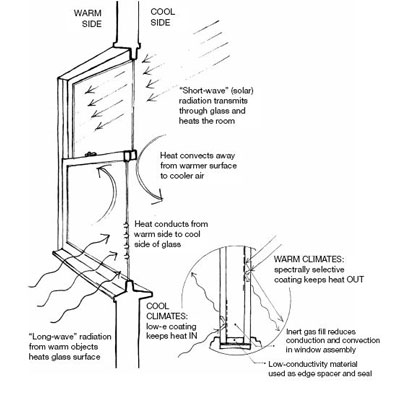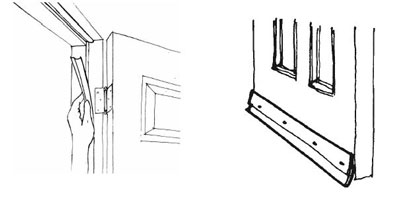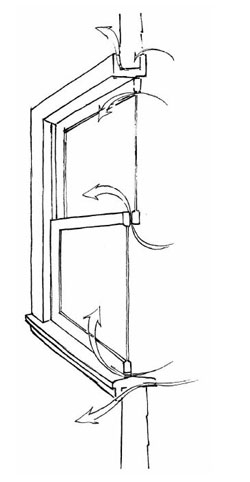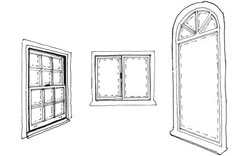Upgrade Inefficient Windows and Doors
About one-quarter of a home’s total heat loss during colder months usually occurs through windows and doors. In the summer, about one-third of the heat that enters a house is from the sun shining through.
But windows are not a total negative in terms of your home’s energy performance. On the positive side, windows can be used for passive solar heating in the winter months to help reduce heating costs, and of course windows provide natural daylighting and views to the outside world.
Because windows outnumber doors, we devote the vast majority of this section to them. That said, some of the considerations about windows apply to doors as well, like the importance of weatherstripping or frame material.
Understanding How Windows Work
To understand how windows affect heating and cooling costs, we need to know a little about how energy flows through them. The next illustration shows the primary mechanisms of heat transfer through windows.
Sunlight. Solar radiation is an important source of heat and is transmitted directly through most windows. Solar radiation consists of visible light and a part of the solar spectrum that is heat but not visible light (infrared heat radiation). Glazings are available that selectively transmit light of different wavelengths—for example, some appear totally clear (high visible light transmittance) while blocking infrared heat radiation. A window’s solar heat gain coefficient (SHGC) is the measure of the amount of solar energy that passes through the window; typical values range from 0.2 to 0.7, and the higher the SHGC, the greater the percentage of solar energy that is transmitted to the inside.

How heat moves through windows
Radiation. Radiant heat is given off by warmer objects to colder objects. Things warmed by sunlight become stronger sources of radiant heat, and radiant heat is blocked by most window glazings. Greenhouses and passive solar heating illustrate the dynamic between sunlight and radiant heat: sunlight passes through glazings, warming objects indoors, but the heat from those objects does not quickly escape back through the glazings, and the space warms up. Special coatings on high-performance windows change the way heat radiation is absorbed and reradiated (see discussion on low-e glazings below).
Conduction. Conduction is the mechanism of heat transfer through physical contact. Heat conducts from the warmer to the cooler side of a window as each molecule excites its neighbor, passing the energy along. Conduction occurs not only through solid materials (window glass and frames), but also through the air space between the layers of glass.
Convection. Convection is the movement of heat in a medium, such as air. The heat is transferred as the molecules of air are physically moved from one place to another. A warm glass surface heats the air next to it, causing the air to rise. A cold glass surface is warmed by the air next to it, and that air mass will fall as it gives up its heat. These convection currents occur on the inside of a window, on the outside, and even between layers of glass if they are separated too far from each other.
Air leakage. Infiltration is the process that carries heat through cracks and gaps around window frames. Infiltration through leaky windows can carry cold air into a house and warm air out. Infiltration is driven by wind and other differences in air pressure, such as warm air rising inside a house.
Should I Replace?
To reduce heat loss and heat gain, you can either fix up your existing windows or replace them with new energy-efficient units. Many people who are worried about high heating costs turn to new windows as an early upgrade. Although new windows are great, they can be expensive, and they rarely pay back their cost quickly enough to be a good investment on energy savings alone. It’s likely that your money would be much better spent on a top-notch energy audit and repair of your insulation, thermal envelope, and ductwork. However, if you plan to replace windows anyway—for comfort, appearance, cleaning convenience, modernization, or any other reason—it almost always pays to invest the small added cost in highly efficient windows rather than minimum-performance ones.
If your existing windows have rotted or damaged wood, cracked glass, missing putty, poorly fitting sashes, or locks that don’t work, you may well be better off replacing them. If the windows are generally in good shape, it will probably be more cost-effective to boost their efficiency by weatherstripping, caulking, and fitting them with storm panels as described in the following section.
Fixing Up Existing Windows
Unless your windows are visibly damaged, there are several simple repairs, from cheap and temporary to more permanent, that will pay for themselves by lowering your heating and cooling bills.
Rope caulk. The quickest and least expensive option is to seal all window edges and cracks with rope caulk. This costs less than $1 per window and only takes a few minutes. Rope caulk may be taken off, stored in foil, and reused for two or three seasons, but once it hardens you should discard it. The upper sash of a double-hung window can be permanently caulked closed if you don’t need to open it.
Weatherstripping. A more permanent solution is to weatherstrip the windows. This is more time-consuming and expensive than installing rope caulk ($8–$10 per window), but it only needs to be done once, it permits you to open the window, and the weatherstripping is out of sight. The type of weatherstripping to use depends on the type of window — both compression-type and V-strip weatherstripping are widely available in home improvement stores. You usually get what you pay for with weatherstripping products, so spend the few extra dollars necessary to get a top-quality product that is likely to hold up over years of use.

Weatherstripping is the most permanent way to cut air leakage around windows and doors. Install door sweeps to reduce airflow underneath doors.
While you’re weatherstripping, don’t forget about your doors. As with windows, make sure your doors are in good shape. Weatherstrip around the whole perimeter to ensure a tight seal when closed. Install quality door sweeps on the bottom of doors if they aren’t already in place. On an old uninsulated metal or fiberglass door, a storm door probably isn’t cost-effective. In fact, a glass storm door may damage the plastic trim on some metal or fiberglass doors by trapping heat.
Storm windows. The next step in improving window energy efficiency is to install some type of storm window. If you have single-glazed windows, storm panels will double their energy efficiency. If you heat with oil, the improved energy efficiency in a cold climate will save about a gallon of oil per square foot of window per year. (That’s an awful lot of oil that is otherwise leaking out of your house and adding to our air pollution woes.) With gas heat, the savings can top 1 therm per square foot of window per year.
The simplest type of storm window is a plastic film taped to the inside of the window frame. Inner storm window kits are readily available from hardware stores. They cost just $3–$8 per window and typically last for one to three years. Some are made of special shrink-tight plastic that you heat with a blowdryer after installation to get rid of wrinkles. These inexpensive plastic films are especially suitable for apartments and condominiums where exterior improvements are not allowed or are not practical.
Removable or operable storm windows with glass or rigid acrylic panes generally make more sense if you plan to stay in the house for more than a few years. Both exterior and interior storm windows are available, though exterior units are far more common. Most people choose aluminum-framed combination storm/screen windows, which are very convenient to operate. Be careful, though. There are big differences among products on the market, especially relative to air tightness. The tightest units have air leakage rates as low as 0.01 cubic feet per minute (cfm) per foot of window edge. Don’t settle for anything higher than 0.3 cfm per foot. Also look for units with low-e coatings on the glass to improve the energy performance.
Storm windows typically cost between $50 and $120, depending on size, quality, and labor for installation — far less than replacement windows. Before buying new storm windows, though, check to make sure you don’t already have a stack in a dusty corner of your basement or attic. If these are older wood-framed storm windows, they probably just need a coat of paint. Although they aren’t quite as convenient as combination storm/screen windows (they have to be taken down and put up each year and separate screens are required), wooden storm windows are often more energy efficient.
If aluminum combination storms are already in place, examine them to make sure they are tightly sealed where mounted to the window casings; if not, caulk all cracks (but do not seal the small weep holes on the bottom edges).
Finally, you can boost the energy efficiency of windows by installing insulating curtains or drapes on the interior. These can be closed at night to significantly cut down on heat loss. They can also be closed on hot summer days to keep out unwanted heat gain. Look for shades or drapes that fit into tracks to keep air from passing around the edges.



